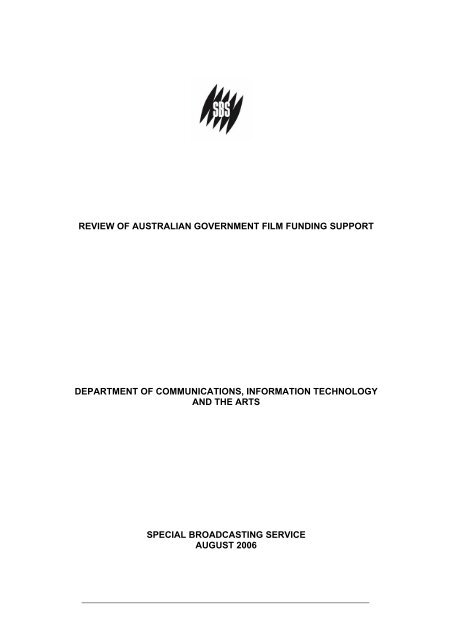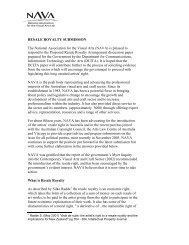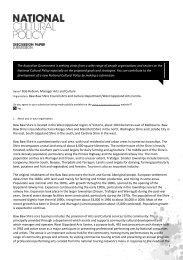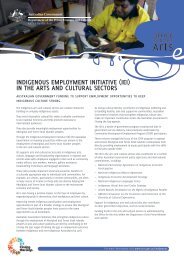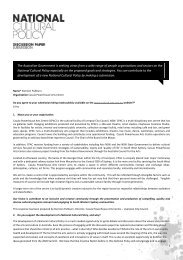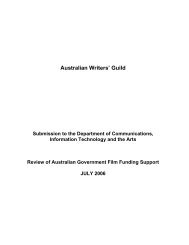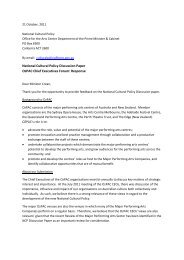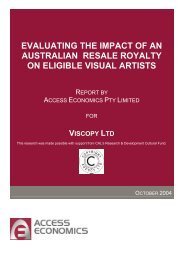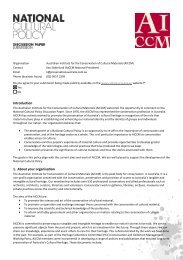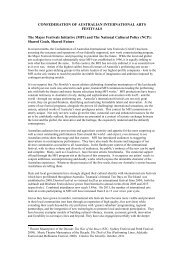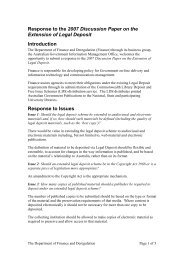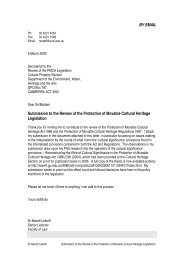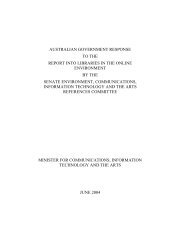SBS (PDF - 93 KB) - Office for the Arts
SBS (PDF - 93 KB) - Office for the Arts
SBS (PDF - 93 KB) - Office for the Arts
You also want an ePaper? Increase the reach of your titles
YUMPU automatically turns print PDFs into web optimized ePapers that Google loves.
REVIEW OF AUSTRALIAN GOVERNMENT FILM FUNDING SUPPORTDEPARTMENT OF COMMUNICATIONS, INFORMATION TECHNOLOGYAND THE ARTSSPECIAL BROADCASTING SERVICEAUGUST 2006
The result may be that even where a broadcaster with a strong track record <strong>for</strong>commissioning quality product supports a production and it has internationalproduction funding, it still may not get financed. Long term, this exacerbatesproducers’ difficulties in obtaining international finance and private sector investment.Just as importantly <strong>for</strong> <strong>SBS</strong>, our ability to schedule programs is hostage to <strong>the</strong>decision making processes (not least timing of funding rounds) of various agencies.<strong>SBS</strong> believes that critical to growing audiences is our ability to commission streamsof quality Australian content that create a coherent whole. <strong>SBS</strong> is best placed tomake <strong>the</strong> decisions necessary to achieve this because of its direct relationships toproducers, <strong>the</strong> market and audiences.THE <strong>SBS</strong> INDEPENDENT MODEL<strong>SBS</strong>i has proved an extremely successful model <strong>for</strong> delivering a combination ofcultural and economic objectives. <strong>SBS</strong>i is unique in <strong>the</strong> funding landscape because itis both directly connected to audiences and commissions all production from <strong>the</strong>independent sector. It is arguably <strong>the</strong> best existing mechanism in Australia <strong>for</strong>delivering government funds to <strong>the</strong> Australian film, television and digital mediaindustries.<strong>SBS</strong>i commissioned programs are developed to deliver to <strong>the</strong> <strong>SBS</strong> Charter. Thismeans <strong>the</strong> work selected <strong>for</strong> production provides audiences with diversity and a richand complex reflection of Australia. In order to achieve this, producers must focus onand engage with <strong>the</strong> needs of <strong>the</strong> audience. At <strong>the</strong> same time <strong>the</strong> strength of <strong>the</strong>independent sector is vital to <strong>the</strong> success of Australian production <strong>for</strong> <strong>SBS</strong> televisionand digital media.Funding channelled through <strong>SBS</strong>i is highly targeted because it allows <strong>for</strong> anexpansion of <strong>SBS</strong> rights acquisitions <strong>for</strong> <strong>the</strong> immediate benefit of Australianaudiences of <strong>the</strong> existing <strong>SBS</strong> channel, on a new digital multichannel, on <strong>the</strong> weband o<strong>the</strong>r emerging plat<strong>for</strong>ms. <strong>SBS</strong>i has demonstrated how funding can be deliveredto production companies through licence fees and equity investments to underpinproduction which engages Australian and international audiences.<strong>SBS</strong>i is appropriately resourced to work with <strong>the</strong> independent sector to combinelicence fees and equity investments with indirect support mechanisms, such as anexpansion of <strong>the</strong> Offset. Because <strong>SBS</strong>i is experienced at partnering with internationalplayers <strong>the</strong>re would be a natural fit with <strong>the</strong> needs of producers seeking to use <strong>the</strong>Offset model. In addition, <strong>SBS</strong>i is poised to work with producers to begin exploitingnew sources of licence income from emerging digital plat<strong>for</strong>ms.<strong>SBS</strong> particularly favours <strong>the</strong> Offset model as it focuses support on <strong>the</strong> economicgrowth of <strong>the</strong> independent sector which now produces 100 percent of all Australiancontent <strong>for</strong> <strong>SBS</strong> (excluding News and Sport). It delivers <strong>the</strong> benefit to producersempowering <strong>the</strong>m to negotiate <strong>the</strong> most effective arrangements with investors,distributors and broadcasters. The Offset model favours audiences because <strong>the</strong>producer will focus on <strong>the</strong> needs of <strong>the</strong> market ra<strong>the</strong>r than <strong>the</strong> needs of fundingbodies. The unique relationship between <strong>SBS</strong>i as a commissioner and <strong>the</strong>broadcaster, <strong>SBS</strong>, ensures that <strong>the</strong> <strong>SBS</strong>i commissioning process works in <strong>the</strong>interest of building Australian audiences3/15 11/8/06
CONTEXTThe Special Broadcasting Service, as a national public broadcaster with a Charter to‘provide multilingual and multicultural radio and television services that in<strong>for</strong>m,educate and entertain all Australians and, in doing so, reflect Australia’s multiculturalsociety’, is a natural home and access point <strong>for</strong> national audiences of <strong>for</strong> high quality,diverse Australian content.<strong>SBS</strong> Independent is <strong>the</strong> commissioning arm of <strong>SBS</strong>. Since 1994, <strong>SBS</strong>i hascommissioned almost 1200 hours of high quality first run drama, documentary,animation and feature films shown on <strong>SBS</strong> Television, with many more currently inproduction. To date, <strong>the</strong>se programs have won over 600 national and internationalawards. In 2005-06 <strong>SBS</strong>i commissioned 267.5 hours of drama, feature films,documentaries and entertainment programs exclusively from <strong>the</strong> independent sector.<strong>SBS</strong> Independent plays a key role in supporting <strong>the</strong> development and growth ofAustralia’s film and television production industry. <strong>SBS</strong>i commissions ongoingAustralian documentary and factual entertainment strands as core business andaf<strong>for</strong>d <strong>the</strong>se strands a high priority <strong>for</strong> promotion and publicity. It has over twentyhours of quality high end drama in production at <strong>the</strong> time of writing.CHALLENGES FACING THE AUSTRALIAN FILM AND TELEVISION PRODUCTION SECTORGrowth in <strong>the</strong> film and television production sector needs to be developed through<strong>the</strong> following:Investment conditions• Improved investment conditions through an expanded Refundable Tax OffsetInvestment in production under <strong>the</strong> existing 10BA and 10B provisions is minimal anddiminishing. <strong>SBS</strong> supports <strong>the</strong> expansion of <strong>the</strong> Offset because it focuses support on<strong>the</strong> producer, eliminates <strong>the</strong> funding bodies as intermediaries and exposes <strong>the</strong>producer directly to <strong>the</strong> market. <strong>SBS</strong>i already works with producers to secureinternational co-production and finance partners. This model creates much greatercertainty <strong>for</strong> <strong>the</strong> producer with regard to financing and <strong>for</strong> <strong>SBS</strong> with regard to deliveryand scheduling.Certainty <strong>for</strong> production sector and broadcasters• Clear, efficient processes and clear criteria <strong>for</strong> direct fundingUncertainty <strong>for</strong> producers directly impacts on <strong>SBS</strong>’s ability to offer attractivescheduling to its audience. Currently producers may do everything ‘right’ – secure anAustralian broadcaster, secure significant international partners, meet guidelines,meet deadlines – and still be denied <strong>the</strong> final twenty percent of direct funding as <strong>the</strong>case study below shows.Case Study 1 - Three hour documentary series: World of ColoursWorld of Colours is an Australian $3.3 million ‘blue chip’ documentary series. Thefinancing package comprises ten international broadcasters, a major Frenchproduction company, two distributors, and two Australian and two internationalfunding agencies. The series has been in development since early 2004 and wascommissioned by <strong>SBS</strong> in September 2005. Broadcaster commitments are based on<strong>the</strong> expectation that <strong>the</strong> series will be delivered in late 2007 and in many casesbroadcasters have already scheduled <strong>the</strong> series. The Producer has secured morethan 50% of <strong>the</strong> budget from international sources.4/15 11/8/06
World of Colours was submitted to <strong>the</strong> FFC in June 2006 requiring just 20% of <strong>the</strong>budget but was not selected <strong>for</strong> financing because <strong>the</strong>re were insufficient fundsavailable in that round. It must now be submitted to <strong>the</strong> FFC in September. TheAustralian and French producers have invested hundreds of thousands of dollars indevelopment and pre-production in order to stay on schedule. The Australianproducer's company will be in jeopardy if <strong>the</strong> project is not financed in September.The co-production partners are exposed and <strong>SBS</strong> cannot plan a schedule aroundthis high impact series with any certainty.Sustainability• Longer term planning – putting in place <strong>the</strong> conditions <strong>for</strong> long-term growth <strong>for</strong>independent producers and <strong>the</strong>re<strong>for</strong>e Australian contentDrama: Quality drama production levels in Australia currently do not achieve <strong>the</strong>critical mass which would allow <strong>for</strong> sustainability, economic growth and culturalrelevance. The total number of hours produced needs to be increased.The failure to achieve critical mass with regard to both <strong>the</strong> total hours produced and<strong>the</strong> viability of long run drama negatively impacts:oooeconomic sustainability <strong>for</strong> <strong>the</strong> independent sector;<strong>SBS</strong>’s ability to schedule long running drama to build audience loyalty; andAustralia’s capacity to sustain creative talent and technical personnel.Documentary: Documentary production needs to be developed at <strong>the</strong> high quality(more expensive, longer running series eg The Colony, Divorce Stories, Who Do YouThink You Are) to ensure significant, ongoing production levels. Such output isrequired to establish Australian producers’ international reputations as regularsuppliers of quality product. Fragmentation of funding and o<strong>the</strong>r obstacles need tobe resolved to provide greater economic viability <strong>for</strong> smaller producers.Development of content <strong>for</strong> new plat<strong>for</strong>ms• Drivers <strong>for</strong> digital uptakeIn order to increase multi-plat<strong>for</strong>m production and production specifically developed<strong>for</strong> emerging plat<strong>for</strong>ms, <strong>the</strong>re needs to be a stronger, more agile and dynamicindustry. Producers need to be upskilled to identify opportunities <strong>for</strong> <strong>the</strong> developmentof multi-plat<strong>for</strong>m productions relevant to emerging audiences. These skills candeveloped through collaboration with broadcasters who are actively engaging withopportunities on new plat<strong>for</strong>ms, such as digital and online pilots. For <strong>SBS</strong>, <strong>the</strong>se arenot optional extras –<strong>the</strong>y are now crucial to its delivery of content to audiences andits role as a public broadcaster.International coproductions and overseas sales• Substantial, distinctive content that will attract audiences in overseas markets.<strong>SBS</strong> commissions drama which is of interest to overseas buyers because it isdistinctive. However <strong>the</strong> number of episodes which can be funded under <strong>the</strong> currentsystem is generally too few to fulfil overseas programmers’ needs – <strong>the</strong>y are looking<strong>for</strong> three or four seasons of thirteen parts in preference to one season of six parts.The current funding arrangement limits Australian independent producers’ capacity tomarket <strong>the</strong>ir drama overseas. In addition short runs contribute to <strong>the</strong> problem ofsustainability because <strong>the</strong>re is not <strong>the</strong> critical mass of production to make economiesof scale available to producers.5/15 11/8/06
Challenges specific to <strong>SBS</strong>In working with <strong>the</strong> independent production sector to develop content to meet Charterobligations and deliver to its schedule, <strong>SBS</strong> faces serious limitations due to <strong>the</strong>rigidity and convoluted processes of <strong>the</strong> current system. <strong>SBS</strong>i currently works withproducers to apply <strong>for</strong> federal funds allocated through o<strong>the</strong>r agencies with differentsets of criteria, a process of ‘artificial leveraging’ as production budgets are ultimatelypieced toge<strong>the</strong>r from <strong>the</strong> same overall pool of Government funds. The impact of thissystem is that <strong>SBS</strong> has little power to commission productions without being secondguessed by agencies far less connected to audience demand and outcomes.Success and sustainability: <strong>the</strong> <strong>SBS</strong>i modelThe <strong>SBS</strong>i model has worked extremely well. <strong>SBS</strong> is committed to increasing <strong>the</strong>number of hours of Australian production on screen, and despite <strong>the</strong> obstacles isdoing so. However it is held back by its inability to offer sufficient licence fees toguarantee that production occurs in sufficient volume to satisfy <strong>the</strong> <strong>SBS</strong>’s needs orthose of overseas investors.In <strong>the</strong> case of documentary production, broadcasters offer a much lower proportion ofbudgets to producers than is available to <strong>the</strong>ir international counterparts. Howeverany increase in <strong>SBS</strong>i licence fees means dropping <strong>the</strong> number of hours delivered to<strong>SBS</strong>. <strong>SBS</strong> needs more hours not less. It would willingly be able to accommodatedouble <strong>the</strong> number of factual hours into its schedule.For drama <strong>the</strong> proportion of budgets offered by <strong>SBS</strong>i as pre-sale is more workable,however <strong>the</strong> budgets are low by international standards. And <strong>the</strong> total amount ofdrama delivered, whilst significantly higher in recent years, is only a tiny fraction of<strong>the</strong> available hours in <strong>the</strong> television schedule.With additional funding, <strong>SBS</strong>i would be able to offer up to 65% of drama anddocumentary production budgets as a licence fee. Toge<strong>the</strong>r with an expanded Offset,this increase to <strong>SBS</strong>i would allow producers to finance production swiftly and withcertainty. This would create an environment where <strong>SBS</strong> could:• commission significantly higher volumes of production;• develop sustainable practices through long-term planning; and• tailor content and schedules to better deliver on <strong>the</strong> <strong>SBS</strong> Charter.If a greater portion of direct funding were allocated to <strong>SBS</strong>i, it would be highlymotivated to work with <strong>the</strong> producer to secure international participation, because <strong>the</strong>more funds that flow from <strong>the</strong>se sources, <strong>the</strong> more work <strong>SBS</strong>i can deliver <strong>for</strong>broadcast. This would constitute genuine leverage by growing <strong>the</strong> net amountsavailable to Australian producers as opposed to <strong>the</strong> artificial leverage of fundingthrough multiple government agencies. Unlike <strong>the</strong> funding agencies, <strong>SBS</strong> is also abuyer in <strong>the</strong> international market with strong existing relationships with o<strong>the</strong>rbroadcasters, distributors and producers, and so is well placed to support Australianproducers’ international sales.With additional funds flowing into <strong>the</strong> independent sector stimulated by <strong>the</strong> Offset,<strong>SBS</strong> envisages direct agency funding would be increasingly applied to innovation,experimentation and <strong>the</strong> development of content <strong>for</strong> new digital plat<strong>for</strong>ms. As an enduser, <strong>SBS</strong> is keen to partner in this development to address <strong>the</strong> current lack ofindustry experience and expertise and to ensure <strong>the</strong> delivery of content to <strong>SBS</strong>’s newplat<strong>for</strong>ms.6/15 11/8/06
INDUSTRY RESPONSIVENESS TO AUDIENCE DEMANDAudiences are seeking greater engagement through media. In order to provide this,industry must develop and build <strong>the</strong> following.Quality Australian content to grow and retain audiences• Engaging audiences/creating markets <strong>for</strong> Australian contentAudience loyalty <strong>for</strong> Australian content, broadcasters and new plat<strong>for</strong>ms can becultivated through <strong>the</strong> development of distinctive, high-quality substantial drama anddocumentary series that build strong positive audience identification.In order to deliver culturally relevant and engaging content <strong>for</strong> Australian audiences,<strong>the</strong>re is a need to immediately increase <strong>the</strong> production of work which targets <strong>the</strong> gapin what is currently available to those audiences. <strong>SBS</strong> has identified <strong>the</strong>se gaps as:• consistently scheduled, long run drama programs;• high quality shorter run drama productions• a greater volume of factual content; and• high quality, <strong>the</strong>med documentary series.In drama, <strong>SBS</strong>i aims to commission an additional 40 hours of long and short rundrama per year, creating audience awareness that <strong>SBS</strong> is a destination <strong>for</strong> innovativeAustralian drama. In documentary, <strong>SBS</strong>i aims to commission <strong>the</strong>med series ofbetween two and thirteen episodes from larger production companies, scheduled intopical seasons with one-off programs contributed by smaller producers.Relevance and appeal• Engaging, local contentIn order to develop Australian content which is relevant and appealing to Australianaudiences, <strong>the</strong>re needs to be a strong relationship between <strong>the</strong> funding decisionmakers, <strong>the</strong> production sector and audiences <strong>for</strong> <strong>the</strong> content.<strong>SBS</strong> is well-placed to assess <strong>the</strong> appeal of content as it has daily engagement withaudiences, measured minute by minute. <strong>SBS</strong> has built audiences <strong>for</strong> Australianfactual content to four times <strong>the</strong>ir previous numbers by committing to regular slots <strong>for</strong>such content. The audience appetite is undoubtedly <strong>the</strong>re, however <strong>the</strong> obstacles todelivering this sort of programs are immense.Case Study 2 - A documentary season on contemporary Australian Muslim life<strong>SBS</strong> decided to commission a 4-6 hour documentary season on contemporaryAustralian Muslim life <strong>for</strong> broadcast in <strong>the</strong> second half of 2007. Two films dealing withdifferent aspects of <strong>the</strong> aftermath of <strong>the</strong> Cronulla riot have been in development sinceFebruary 2006. Both were commissioned by <strong>SBS</strong> prior to submission to <strong>the</strong> FFC inJune 2006. Race <strong>for</strong> <strong>the</strong> Beach secured an international pre-sale from <strong>the</strong> prestigiousBBC2 ‘This World’ international current affairs strand. Race <strong>for</strong> <strong>the</strong> Beach wasfinanced on July 19, but <strong>the</strong> o<strong>the</strong>r program, After Cronulla missed out as <strong>the</strong> FFCdecided that <strong>the</strong> project did not qualify as a documentary under FFC guidelines. Itmust now be resubmitted to <strong>the</strong> FFC in September with no certainty of <strong>the</strong> outcome.Meanwhile <strong>SBS</strong> Commissioning Editors are talking to independent producers todevelop o<strong>the</strong>r documentaries <strong>for</strong> <strong>the</strong> season. However <strong>the</strong>se o<strong>the</strong>r documentarieswill be subjected to <strong>the</strong> same uncertain financing corridors. To be relevant, <strong>the</strong>Cronulla documentaries must go to air while <strong>the</strong> story is still current. In <strong>the</strong>secircumstances a high-profile documentary season cannot be planned with certainty.7/15 11/8/06
Building Audiences <strong>for</strong> Australian contentThe 2006 Connecting Diversity: Paradoxes of Multicultural Australia study revealedthat younger Australian audiences consider cultural diversity to be a mainstream inAustralian society, engage critically with media content and are seeking betterengagement with media content. <strong>SBS</strong> Charter content challenges stereotypes andengages with social issues in creative ways in order to reflect contemporaryAustralian diversity. <strong>SBS</strong> also has a direct responsive relationship to audiencesdeveloped through:ooaudience measurement conducted on a minute-by-minute basisregular qualitative research conducted on audience attitudes andengagement with particular types of content.In order to attract and engage audiences with its Australian content, <strong>SBS</strong>i aims tocommission programs of an international standard, on a par with <strong>the</strong> best worldprogramming which is regularly shown on <strong>SBS</strong> and schedule <strong>the</strong>se in consistent,well-promoted branded series.8/15 11/8/06
GOVERNMENT SUPPORTBuilding a Strong Independent Production Sector<strong>SBS</strong> believes that Government funding is most appropriate when it results in a directrelationship between <strong>the</strong> production sector and audiences. In Australia, as in mostcountries, those audiences are primarily television audiences. Streng<strong>the</strong>ning <strong>the</strong>economic position of independent producers should be a priority. Instead of fundingproject development and production through agencies that are one step removedfrom audiences <strong>SBS</strong> recommends a model which allows producers to engagedirectly with broadcasters and private investors. This would require higher licencefees from broadcasters and increased incentives <strong>for</strong> investment in <strong>the</strong> sector.Diversity and Cultural ValueThe Government’s cultural objectives <strong>for</strong> <strong>the</strong> film industry, of ensuring a ‘rich varietyof high quality film, television and o<strong>the</strong>r audio-visual productions’ and maintaining anemphasis on work that is ‘culturally significant’ are well served by <strong>the</strong> approach of<strong>SBS</strong>i. <strong>SBS</strong>i has a commitment to commissioning a diversity of content, styles,perspectives and <strong>for</strong>mats, all of which deliver on <strong>the</strong> <strong>SBS</strong> Charter.DIRECT FUNDINGDirect support is a crucial part of Government policy <strong>for</strong> film and television however<strong>the</strong> existing arrangements have created considerable obstacles to <strong>the</strong> fur<strong>the</strong>rdevelopment of <strong>the</strong> industry. <strong>SBS</strong> believes that direct funding should have as itsprimary objective <strong>the</strong> expansion of film, television and digital media offerings to <strong>the</strong>Australian public.Issues facing broadcasters and producersThere are currently a range of obstacles in accessing direct funding which limit <strong>the</strong>effectiveness of funding in <strong>the</strong> sustaining <strong>the</strong> industry. These include:Fragmentation of <strong>the</strong> domestic financing systemThe domestic financing system is highly fragmented. It comprises numerous fundingand production agencies at both State and Federal government level, each typicallycontributing no more than 15 - 60% of any production budget. Within one agency<strong>the</strong>re may be several programs relating to different stages of development.Domestic investors in <strong>SBS</strong>i productions include <strong>the</strong> Film Finance Corporation, <strong>the</strong>Australian Film Commission, Film Australia, <strong>the</strong> NSW Film and Television office, FilmVictoria, Pacific Film and Television Commission, ScreenWest, Screen Tasmania,and <strong>the</strong> South Australian Film Corporation.No single funding organisation can effectively commission quality television drama ordocumentary of any scale. For <strong>the</strong> vast majority of production, a pre-sale is requiredto trigger agency funding. However, a pre-sale does not ensure agency funding.At <strong>the</strong> most basic level <strong>the</strong> need to put toge<strong>the</strong>r multiple agency funding consumesinordinate amounts of independent producers’ time which should be spent on <strong>the</strong>production. This problem flows through <strong>the</strong> industry. Productive time is disabled andsquandered as key creative personnel try to keep <strong>the</strong>mselves available <strong>for</strong> ‘blue chip’projects throughout <strong>the</strong> months of uncertainty resulting primarily from <strong>the</strong> fragmentedfunding process.9/15 11/8/06
Competing agendas between funding agenciesWhile <strong>the</strong>y share some common broad intentions, <strong>the</strong> agencies (and <strong>the</strong> programswithin <strong>the</strong>m) have multiple criteria and agendas. When <strong>the</strong>se criteria are notcompatible with each o<strong>the</strong>r <strong>the</strong>y can cause projects to become distorted <strong>for</strong> <strong>the</strong> sakeof raising <strong>the</strong> budget.Although <strong>SBS</strong>i is usually <strong>the</strong> first to make an offer on a future <strong>SBS</strong> production, <strong>the</strong>producer carries <strong>the</strong> risk until <strong>the</strong> financing package is in place, at which time <strong>SBS</strong>and <strong>the</strong> o<strong>the</strong>r parties contract with <strong>the</strong> producer. On <strong>the</strong> basis of an offer from <strong>SBS</strong>,producers can spend months or even years approaching investors both in Australiaand overseas, but may ultimately not be able to finance <strong>the</strong> production because <strong>the</strong>yare deemed not to meet <strong>the</strong> criteria of one or more investment agencies.Agency development funding is disconnected from commissioning processesThe agencies develop projects independent of <strong>the</strong> broadcasters’ commissioningintentions. This is seen by some as a “many doors” approach. <strong>SBS</strong> believes this isoften an unproductive use of government funds.. If <strong>the</strong> market has no intention ofcommissioning <strong>the</strong> developed project, <strong>the</strong>re should be question as to whe<strong>the</strong>r itshould be funded in <strong>the</strong> first place. This is not to say that <strong>the</strong>re is no place <strong>for</strong>development of innovative or speculative content. However, this should be limitedand in general it would be better if broadcasters’ intentions were a primaryconsideration in funding decisions. <strong>SBS</strong> believes that broadcasters should determine<strong>the</strong>ir own development priorities as <strong>the</strong>y are closest to <strong>the</strong> market/audience.Case Study 3 - The disconnection between commissioning and funding<strong>SBS</strong>i may partner in <strong>the</strong> development of project which may attract <strong>the</strong> interest of FilmAustralia. Film Australia <strong>the</strong>n requires that all rights (included <strong>SBS</strong>’s rights) beassigned to <strong>the</strong>m. In one recent instance, a project went through eighteen months ofdevelopment (Film Australia’s choice of development path, not necessarily <strong>the</strong>producer’s nor <strong>SBS</strong>i’s) and <strong>the</strong>n Film Australia decided not to proceed and returned<strong>the</strong> project back to <strong>the</strong> producer with an initial bill heading <strong>for</strong> $70K. So a project<strong>SBS</strong>i has identified it wants to commission and, in this example, did commission, hasbeen held up <strong>for</strong> a very long period of time and <strong>the</strong>n massively financially burdened.Funding decision datesEach Australian funding agency operates its own project assessment and approvalprocess with application rounds occurring as infrequently as once, twice, or fourtimes a year, with decisions taking ten weeks or more to be finalised.Production development: Typically once <strong>SBS</strong> expresses interest in seeing aproduction idea developed <strong>the</strong> producer must <strong>the</strong>n approach one or more agency tofinance or co-finance development with <strong>SBS</strong>.Production: Once <strong>SBS</strong> decides to commission a project and makes a licence feeoffer to <strong>the</strong> producer (typically 10-50% of <strong>the</strong> production costs), <strong>the</strong> producer must<strong>the</strong>n approach two or more funding agencies in order to finance <strong>the</strong> production.Producers with higher budget productions with overseas market potential face evenmore complex financing models, typically involving up to ten internationalbroadcasters, international financing agencies, sales agents or distributors, anAustralian broadcaster and two or three Australian government agencies.As a result of this system, it usually takes a producer a year or more just to finance arelatively simple production. Complex productions with numerous internationalplayers may take two or three years to finance.10/15 11/8/06
Every Australian program that <strong>SBS</strong>i commissions is subject to <strong>the</strong> fragmentation of<strong>the</strong> domestic financing system, protracted funding deadlines, and competing fundingcriteria. This state of affairs creates great uncertainty <strong>for</strong> <strong>SBS</strong> as a broadcaster. It isvery difficult to commission <strong>for</strong> <strong>the</strong> schedule or to commission <strong>the</strong>mes of topicalinterest to <strong>the</strong> Australian audience because <strong>the</strong> financing corridors are extremelyslow and <strong>the</strong> outcomes are uncertain.Case Study 4 - Wedding Sari Showdown sequel episodesWedding Sari Showdown was an award winning, critically acclaimed half hourdocumentary by a first time filmmaker that screened on Inside Australia in 2006.<strong>SBS</strong> decided to commission two sequel episodes based on time critical events, witha total production budget of $250,000. Although <strong>the</strong> production is currently beingfilmed, <strong>the</strong> Producer's financing corridor involves four applications to two agencies,with <strong>the</strong> last agency decision not due until 15 December 2006, four months be<strong>for</strong>e<strong>the</strong> Producer is due to deliver <strong>the</strong> completed programs to <strong>SBS</strong>.Wedding Sari Showdown Sequel Funding Application decision dates:AFC Time Critical Funding: 28 July 2006Film Victoria Production Investment: 29 August 2006Film Victoria Production Investment: 28 November 2006AFC Production Investment: 15 December 2006In order to assist <strong>the</strong> Producer <strong>SBS</strong> will offer a small production advance and providea staggered payment schedule on <strong>the</strong> contract, so that <strong>the</strong> first episode will be cashflowed be<strong>for</strong>e <strong>the</strong> second episode is financed. However nei<strong>the</strong>r <strong>SBS</strong> nor <strong>the</strong> producerhas any certainty that <strong>the</strong> series will ultimately be financed by <strong>the</strong> o<strong>the</strong>r agencies.‘Many doors’ leading nowhere<strong>SBS</strong>i does not agree that <strong>the</strong> current system actually offers many doors to producers.Ra<strong>the</strong>r we see that it offers fragmentation, prevarication and inefficiency. Theexperience of independent producers is that without a broadcaster’s involvement<strong>the</strong>y cannot trigger significant production funding, however <strong>the</strong> failure of any oneagency to participate can thwart production. This is a negative model and certainlydoes not provide ‘many doors’ to successful production, distribution or delivery to anaudience. Many producers are <strong>for</strong>ced to develop and cash flow <strong>the</strong>ir own productionsbecause of <strong>the</strong> fragmented funding system, yet <strong>the</strong>y are generally disallowed (by <strong>the</strong>same funding bodies) from taking <strong>the</strong> sort of risk reward that such action wouldgenerate in o<strong>the</strong>r industries. Consolidation of funding arrangements would removemuch of <strong>the</strong> pressure to take such risks or alternatively may allow it to be properlyrewarded.A Unified AgencyFor television drama and factual programming <strong>SBS</strong>i supports <strong>the</strong> <strong>for</strong>mation of aunified agency to continue to per<strong>for</strong>m many of <strong>the</strong> cultural and industry developmentprograms currently supported by <strong>the</strong> AFC. A small proportion of funds should be setaside within <strong>the</strong> unified agency <strong>for</strong> experimentation and innovation.<strong>SBS</strong>i supports <strong>the</strong> on-going direct funding of feature films through an FFC stylequalitative assessment process. This is a flexible mechanism that combinesassessment by industry professional with <strong>the</strong> need <strong>for</strong> some marketplacecommitments. This mechanism should be maintained <strong>for</strong> feature films with productionbudgets up to $8 million.11/15 11/8/06
<strong>SBS</strong> is concerned that restructuring <strong>the</strong> funding bodies and introducing an Offset atexactly <strong>the</strong> same time will cause massive disruption in an industry that is currentlynot robust. The expansion of Offset would have to be assessed <strong>for</strong> effectivenessbe<strong>for</strong>e any substantial cuts to direct funding.INDIRECT FUNDINGThe Refundable Tax Offset and <strong>the</strong> <strong>SBS</strong>i modelThe 2004 Government election policy noted <strong>the</strong> Governments’ commitment to <strong>the</strong>Offset including its extension to television series and serials. The Offset schemecurrently provides a rebate of 12.5 per cent of eligible film production costs in caseswhere qualifying Australian expenditure exceeds $15 million. <strong>SBS</strong> strongly supports<strong>the</strong> expansion of <strong>the</strong> Offset model. Extending <strong>the</strong> Offset option to increaseinvestment in <strong>the</strong> independent production sector would empower producers andeffectively build indirect funding into <strong>the</strong> industry. It would allow <strong>for</strong> more flexibilityand sustainable development of <strong>the</strong> production sector overall.The balance between support mechanisms needs to be shifted in favour ofaudiences. <strong>SBS</strong> believes this will be best achieved by a model that favours a moredirect relationship between filmmakers and <strong>the</strong> market. This direct relationship willoccur if <strong>the</strong>re is an appropriate adjustment to <strong>SBS</strong>i’s ability to offer licence fees thatdovetail with <strong>the</strong> Offset level. Government funds re-directed to <strong>SBS</strong>i will be fundingrights acquisitions <strong>for</strong> Australian audiences and increasing <strong>the</strong> diversity ofprogramming available to Australian audiences.With appropriate adjustment to <strong>the</strong> funds available <strong>for</strong> <strong>SBS</strong>i ‘pre-sales’ <strong>the</strong>re wouldbe fewer obstacles to <strong>the</strong> <strong>SBS</strong>i commissioning process, thus efficiently triggeringsignificant production from <strong>the</strong> independent sector. This would create certainty,greater sustainability and would allow <strong>SBS</strong> to build audiences <strong>for</strong> Australian content.It is not expected that significant changes to production budgets would result from <strong>the</strong>Offset. Most budgets already carry substantial costs in <strong>the</strong> <strong>for</strong>m of legal fees <strong>for</strong>servicing agreements with multiple parties and FFC fees that would no longer beapplicable. Producers may also be able to take advantage of a number of Statebased cash-flow facilities that are already operating – effectively allowing <strong>the</strong>m toinvest in <strong>the</strong> own productions without any of <strong>the</strong> abuses that occurred under 10BA.<strong>SBS</strong> supports <strong>the</strong> Offset being expanded to allow access to Australian producerswith projects with production budget minimums as follows:$1 million <strong>for</strong> feature films$500K per hour <strong>for</strong> television drama$200K per hour <strong>for</strong> documentaries$250K per hour <strong>for</strong> long run drama<strong>SBS</strong> believes <strong>the</strong> Offset percentage of budget should be:45% <strong>for</strong> feature films35% <strong>for</strong> ‘high-end’ drama35% <strong>for</strong> documentaries20% <strong>for</strong> long run drama seriesThe current 10BA/10B schemes<strong>SBS</strong> supports <strong>the</strong> continuing existence of <strong>the</strong> 10BA/10B schemes in <strong>the</strong>ir current taxneutral<strong>for</strong>ms <strong>for</strong> non-Offset productions until <strong>the</strong> Offset model is clearly stimulatingsubstantial production.12/15 11/8/06
NEW COMMISSIONING EQUATIONThe proposed model would allow <strong>SBS</strong>i to contribute licence fees in a range up to65% of <strong>the</strong> budget as follows:Factual Productions35% distributors, international co-production funds, privatefinance utilising Refundable Tax Offset Scheme.65%40%New maximum licence fee (65%)Current <strong>SBS</strong>i licence fee (10% - 40%)Drama Productions65%50%35% distributors, international co-production funds, privatefinance utilising Refundable Tax Offset Scheme.New maximum licence fee (65%)Current <strong>SBS</strong>i licence fee (generally 50%)The 65% licence fee would be <strong>the</strong> maximum required to trigger production. <strong>SBS</strong>i has<strong>the</strong> expertise to accurately predict <strong>the</strong> particular presale level required <strong>for</strong> eachproduction, taking into consideration international funding opportunities, StateGovernment commitments and potential private investment.Genres and plat<strong>for</strong>msThe Offset model combined with <strong>SBS</strong>i’s commissioning practices will stimulatesignificant development across a range of genres.<strong>SBS</strong> believes that <strong>the</strong>re is room <strong>for</strong> stronger support of television drama, factualprogramming and also drama and factual programming specifically designed <strong>for</strong>multi-plat<strong>for</strong>m and emerging plat<strong>for</strong>m dissemination. As <strong>SBS</strong>i has increased <strong>the</strong>commissioning of Australian documentaries, <strong>the</strong> audience <strong>for</strong> this work has grownvigorously. There is now very strong demand <strong>for</strong> factual programming with audiencesreaching four times <strong>the</strong> levels of recent years. There is clearly a ‘greater appetite’than <strong>the</strong>re are available funds. As has been proved with documentary, <strong>SBS</strong> expectsaudience demand <strong>for</strong> Australian drama to grow in response to more hours beingaired. <strong>SBS</strong> has a track record of innovation with regard to work that expands andcrosses traditional genre boundaries as well as pioneering new animation talent suchAdam Elliot, director of <strong>the</strong> Oscar winning Harvey Krumpet.13/15 11/8/06
DEVELOPMENT AND SKILLS IN THE FILM INDUSTRYDevelopmentSupporting <strong>SBS</strong>i’s ability to offer appropriate licence fees will underpin privateinvestment and expand engagement with <strong>the</strong> international market. In this contextproducers should be able to marginally increase <strong>the</strong> overhead components of <strong>the</strong>irbudgets from less than 3% to around 10%. The current figure cripples independentproducers and <strong>for</strong>ces <strong>the</strong>m back to <strong>the</strong> funding agencies <strong>for</strong> meagre developmentfunds even after successful productions. A reasonable overhead will allow <strong>the</strong>m tore-invest in <strong>the</strong> development of <strong>the</strong>ir own work - most probably co-funding it with anend user such as <strong>SBS</strong>. Producers will be able to seek a much clearer indication of<strong>the</strong> level of market/audience interest in <strong>the</strong>ir project be<strong>for</strong>e spending <strong>the</strong>ir own funds.Similarly, better resourced producers will be in a position to support apprentices.Currently, funding bodies have something of a monopoly on <strong>the</strong> development of newtalent. <strong>SBS</strong> consistently encourages producers to work with new talent and hasdevised numerous creative ways to support <strong>the</strong>m whilst still delivering quality work toits audiences. Diversity of production companies as well as diversity of product wouldbe served by fur<strong>the</strong>r supporting producers to participate financially in developing <strong>the</strong>irown slate and to support apprentices.Cultural Value and Commercial Success<strong>SBS</strong> strongly believes that cultural value and commercial success are not mutuallyexclusive. It is, however, important to acknowledge that <strong>the</strong> latter does not guarantee<strong>the</strong> <strong>for</strong>mer. Commercially sustainable models should be implemented in line withstrong incentives <strong>for</strong> <strong>the</strong> development of diverse content which is of cultural benefit toAustralia. <strong>SBS</strong>i commissions productions according to <strong>the</strong> <strong>SBS</strong> Charter and <strong>the</strong>Strategic Principles of <strong>SBS</strong>i. These set clear goals <strong>for</strong> reflection a range ofcontemporary voices in Australia film and media.<strong>SBS</strong>i is also well placed to assist in <strong>the</strong> commercial success of projects both withinAustralia and overseas. <strong>SBS</strong>i employs a small group of commissioning editors – allof whom have worked professionally as writers, directors and producers of film andtelevision. They are experienced in guiding filmmakers both creatively andcommercially. Working alongside <strong>SBS</strong> Television and <strong>SBS</strong> Digital Media, <strong>the</strong>y areacutely aware of <strong>the</strong> needs of <strong>the</strong> broadcaster and highly sensitive to audiencedemand. They can advocate <strong>for</strong> <strong>the</strong> needs of <strong>the</strong> network to <strong>the</strong> filmmakers and visaversa in a manner that streng<strong>the</strong>ns both.<strong>SBS</strong>i helps producers understand <strong>the</strong>ir Australian audiences. When considering newprograms, commissioning editors predict <strong>the</strong> demographics of <strong>the</strong> audience, proposetimeslots, consider <strong>the</strong> attractiveness of titles, look <strong>for</strong> marketing and publicityopportunities, consider classification, ratings, legal issues and a whole raft of o<strong>the</strong>raudience-based concerns. These issues are not <strong>the</strong>oretical in <strong>the</strong> way <strong>the</strong>y might be<strong>for</strong> a funding agency – <strong>the</strong>y are of utmost importance.Commissioning editors regularly attend international markets where <strong>the</strong>y workdirectly with <strong>the</strong> filmmakers helping <strong>the</strong>m identify co-production partners. Success at<strong>the</strong>se markets is extremely important <strong>for</strong> <strong>SBS</strong>i. Failing may mean a significant holein <strong>the</strong> schedule, <strong>the</strong> collapse of a season, or <strong>the</strong> loss of a peak promotionalopportunity <strong>for</strong> new work (<strong>for</strong> example during <strong>the</strong> <strong>SBS</strong> FIFA World Cup coverage).<strong>SBS</strong> Television is also a buyer in <strong>the</strong> international market, with strong existingrelationships with o<strong>the</strong>r broadcasters, distributors and producers, and so is wellplaced to support Australian producers with international sales.14/15 11/8/06
<strong>SBS</strong>I AND THE RELATIONSHIP TO THE BROADCAST ENVIRONMENT<strong>SBS</strong>i can contribute to production through pre-sales and investment in any proportionto <strong>the</strong> total budget. Commonly this is in a range from 10% - 100%. <strong>SBS</strong>i is perfectlypositioned to target <strong>the</strong> exact amount of funds required to ensure production occurs.<strong>SBS</strong>i may offer a licence fee and investment amount which requires <strong>the</strong> producer tosecure overseas funds. Whereas funding bodies tend to get tripped up by <strong>the</strong>ir ownguidelines, <strong>SBS</strong>i is in a position to observe <strong>the</strong> market response to a project,determine <strong>the</strong> value of <strong>the</strong> project to <strong>the</strong> <strong>SBS</strong> audience and <strong>the</strong>n adjust <strong>the</strong>commitment up or down accordingly. <strong>SBS</strong>i functions as an appropriate market <strong>for</strong>cetaking into account many factors including, <strong>for</strong> example, its previous commitment todevelopment of <strong>the</strong> project. In <strong>the</strong> current multi-agency model, significantdevelopment funds committed by one agency are of no particular concern to ano<strong>the</strong>ragency’s production investment commitments.<strong>SBS</strong> is an end user and <strong>SBS</strong>i is its supplier. <strong>SBS</strong>i is committed to identifyingsuccessful producers and rewarding and building on <strong>the</strong>ir success. This is animperative <strong>for</strong> <strong>SBS</strong>i, as it is measured against <strong>the</strong> Charter and <strong>the</strong> per<strong>for</strong>mance of allits content with national Australian audiences. Building <strong>the</strong> applicability of resourcesin this environment would streng<strong>the</strong>n <strong>the</strong> industry by directly and straight<strong>for</strong>wardlyengaging producers, audiences and <strong>the</strong> market.Special Broadcasting ServiceAugust 200615/15 11/8/06


